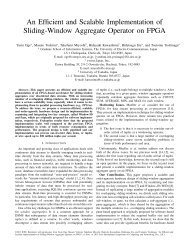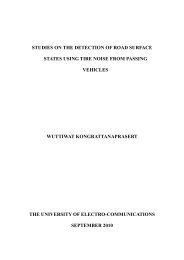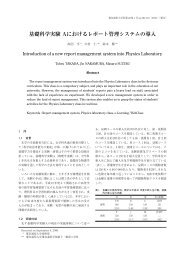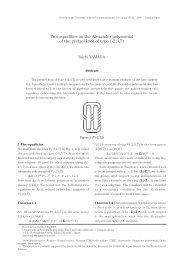Approximation of Hessian Matrix for Second-order SPSA Algorithm ...
Approximation of Hessian Matrix for Second-order SPSA Algorithm ...
Approximation of Hessian Matrix for Second-order SPSA Algorithm ...
You also want an ePaper? Increase the reach of your titles
YUMPU automatically turns print PDFs into web optimized ePapers that Google loves.
2.6 FISHER INFORMATION MATRIX<br />
under the same rate <strong>of</strong> convergence. Under this circumstance, there is no superiority <strong>of</strong> either<br />
one <strong>of</strong> M2-<strong>SPSA</strong> and 2nd-<strong>SPSA</strong> to the other in terms <strong>of</strong> the efficiency or the rate <strong>of</strong><br />
convergence. The superiority <strong>of</strong> our proposed <strong>SPSA</strong> algorithm to 2nd-<strong>SPSA</strong> indicated by (2.25)<br />
only shows an improvement in the multiplier <strong>for</strong> the convergence rate ( R<br />
0<br />
) when the common<br />
convergence rate is sub-optimal. In [25] is showed that by setting α = 1 and γ = 1 / 6<br />
asymptotically optimal MSE can be achieved with a maximum rate <strong>of</strong> convergence <strong>for</strong> the MSE<br />
<strong>of</strong><br />
−<br />
/ 3<br />
θˆ <strong>of</strong> k β = k<br />
− 2 in both 1st-<strong>SPSA</strong> and 2nd-<strong>SPSA</strong>. We have already shown that in <strong>order</strong> to<br />
k<br />
avoid the violation <strong>of</strong> the condition min<br />
i<br />
( λ<br />
i<br />
/ λ ) ≥ β / 2 the setting <strong>of</strong> α = 1 (with β ≈ 2 / 3 )<br />
is <strong>of</strong>ten not allowed in our proposed <strong>SPSA</strong> algorithm. Neither is it possible to choose a different<br />
set <strong>of</strong><br />
α and<br />
m<br />
γ to yield<br />
m<br />
β<br />
m<br />
= 2 / 3 when γ = 1 / 6<br />
an<br />
. Under this circumstance, the<br />
/ 3<br />
maximum rate <strong>of</strong> convergence <strong>of</strong> − 2 <strong>for</strong> MSE cannot be achieved by our proposed <strong>SPSA</strong>. It<br />
is noted that the mapping<br />
k<br />
f<br />
k<br />
such as the one proposed in Sec. 2.3 will leave the asymptotic<br />
H<br />
k<br />
unchanged (when we set<br />
Λˆ = Λ ) as k → ∞ . On the other hand, our proposed <strong>SPSA</strong><br />
k<br />
k<br />
algorithm changes<br />
H<br />
k<br />
when its<br />
Λ is replaced by Λ .<br />
k<br />
k<br />
2.6 -Fisher In<strong>for</strong>mation <strong>Matrix</strong><br />
2.6.1 -Introduction to Fisher In<strong>for</strong>mation <strong>Matrix</strong><br />
In this section, we presented a relatively simple MCNR method <strong>for</strong> obtaining the FIM that is<br />
used in <strong>order</strong> to estimate the <strong>Hessian</strong> matrix efficiently. So that, the resampling-based method<br />
relies on an efficient technique <strong>for</strong> estimating the <strong>Hessian</strong> matrix. The FIM plays a central role<br />
in the practice and theory <strong>of</strong> identification and estimation. This matrix provides a summary <strong>of</strong><br />
the amount <strong>of</strong> in<strong>for</strong>mation in the data relative to the quantities <strong>of</strong> interest [22]. Suppose that the<br />
i-th measurement <strong>of</strong> a process is<br />
z<br />
i<br />
and that a stacked vector <strong>of</strong> n such measurement vectors is<br />
n<br />
T T T<br />
[ z z z ] T<br />
z ≡ ,...,<br />
1<br />
,<br />
2<br />
n<br />
. Let us assume that the general <strong>for</strong>m <strong>for</strong> the joint probability density or<br />
probability mass function <strong>for</strong><br />
zn<br />
is known, but that this function depends on an unknown vector<br />
θ . Let the probability density/mass function <strong>for</strong><br />
z be z( ζ θ ) where ζ (“zeta”) is a<br />
n<br />
p f<br />
31

















